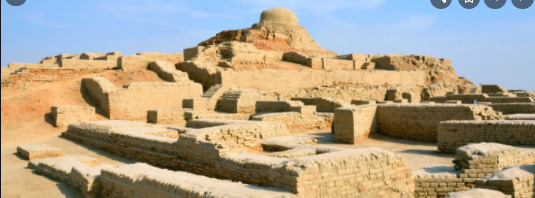#humal khan
Text
Dancing Girl

In 1926, in "HR district" of Mohenjo-daro, a 10.5-ccm (4.1 in) high bronze statuette was found in the National Museum of New Delhi named "Dancing Girl" and was around the age of 4,500 years old. The British archeologist Mortimer Wheeler identified the piece in 1973 as his favorite sculpture:
"I should say about 15, not more, but she poses with her arms all the way out with nothing else on her. She's about 15 years old. A girl who has perfect faith in herself and the world for the time being. In the universe, I guess, there's nothing like her."
References:
Thought Co. 2021. Who Was the Famous Dancing Girl of Mohenjo-Daro?. [online] Available at: <https://www.thoughtco.com/the-dancing-girl-of-mohenjo-daro-171329> [Accessed 15th feb2021].
Joy of Museums Virtual Tours. 2021. Dancing Girl (Mohenjo-daro) from the Indus Valley Civilization – Joy of Museums Virtual Tours. [online] Available at: <https://joyofmuseums.com/museums/asia-museums/india-museums/national-museum-new-delhi/dancing-girl-mohenjo-daro/> [Accessed 15th Feb 2021].
Flickr. 2021. Dancing Girl Of Mohenjodaro, Indus Valley Civilization. [online] Available at: <https://www.flickr.com/photos/mukulb/5212019674> [Accessed 15th Feb 2021].
1 note
·
View note
Text
Architectural of Mohenjo Daro
Mohenjo-daro has a scheduled architecture with a grid plan for rectilinear houses. . Much of the houses were fired and burned stone, some of which had sun-dried mud brick and wooden superstructures. The Mohenjo-daro covered area of 300 hectares is projected. A "bad" estimation of a peak population of about 40 000 can be found in the Oxford City Handbook of World History. It indicates a high degree of social organisation, because of its scale and its provision of public buildings and services.
The city, the so-called Citada and the Lower City, are divided into two parts. The Citadel, a 12-metre-tall mud-brick mound, has public baths sponsored,
a massive complex built to host about five thousand people and two large assembly halls. The town had a central market, and the center was big. Person households or families were given water from smaller wells. Waste water was channeled into filled drains along the main roads. Some homes, more prestigious occupants of which potentially have more rooms, have bathrooms, and one building has an underground (hypocaust) oven, likely for heated baths. Many houses had courtyards, with doors opening on side streets. Any constructions have two storiesa massive complex built to host about five thousand people and two large assembly halls. The town had a central market, and the center was big. Person households or families were given water from smaller wells. Waste water was channeled into filled drains along the main roads. Some homes, more prestigious occupants of which potentially have more rooms, have bathrooms, and one building has an underground (hypocaust) oven, likely for heated baths. Many houses had courtyards, with doors opening on side streets. Any constructions have two stories.

References:
Tspace.library.utoronto.ca. 2021. [online] Available at: <https://tspace.library.utoronto.ca/bitstream/1807/79338/3/Mosher_Matthew_S_201706_PhD_thesis.pdf> [Accessed 15 Feb March 2021].
0 notes
Text
Art and Memory
Historical place of pakistan
For its cultural heritage and diversity, Pakistan is a place rich. In Pakistan, there are many historic sites that everyone needs to visit.
In reality, we have several World Heritage Sites in the United Nations. The UN School, Scientific and Cultural Organisation's preservation of these sites (UNESCO). So you have to fly to them.
Besides this, Pakistan must be assumed to be spiritual, geological and archeological sites. Here's a list of Pakistan's historical places that are worthy of your tour.
Mohenjo-daro (/mo file holder of the death men[mu file holder of the diet holder of the diet obligation holder of the dies holder of the land holder of the family [mu file holder of the land holder of the family]) is an archeological site in Sindh, Pakistan. Constructed about 2500 BCE, the town was one of the main towns in the ancient Indus valley and one of the oldest cities in the world, at the time of ancient Egyptian, Mesopotamian, Minoan and northern Chico cultures. Due to the diminishing civilization in the Indus Valley in the XIX century BCE and its redescovery in the 1920s, Mohenjo-daro had been deserted. The city site has since been the UNESCO World Heritage Site in 1980 with considerable excavation.
In the 26th century BCE Mohenjo-daro was founded. The Harappan civilization, which developed around the year 3000 BCE in the Indus prehistoric culture, was also one of the major cities of ancient indus-valley civilization. At its heights, the Indus civilization spread to Pakistan and Northeast India, to the west to the Iranian frontier, to Gujarat in India, and to the north to the Bactrian outpost, with large cities in Harapa, Mohenjo-daro, Lothal, Kalibangan, Dholavira, and Rakhigarhi. Mohenjo-daro, with amazingly smart civil and town planning, was the most advanced town in its history.

References:
Encyclopedia Britannica. 2021. Mohenjo-daro | archaeological site, Pakistan. [online] Available at: <https://www.britannica.com/place/Mohenjo-daro> [Accessed 15th Feb2021].
History. 2021. Lost City of Mohenjo Daro Puzzles Archaeologists. [online] Available at: <https://www.nationalgeographic.com/history/article/mohenjo-daro> [Accessed 15th Feb 2021].
0 notes